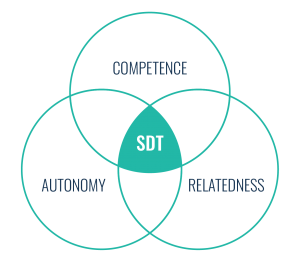 Humans are social animals by nature. Consequently, we see better results when we incorporate social elements into activities. Think about a task that you don’t particularly enjoy doing. Now think about doing it with your best friend. It becomes a bit more appealing doesn’t it? That’s one of the many benefits of social learning.
Humans are social animals by nature. Consequently, we see better results when we incorporate social elements into activities. Think about a task that you don’t particularly enjoy doing. Now think about doing it with your best friend. It becomes a bit more appealing doesn’t it? That’s one of the many benefits of social learning.
We’re hard-wired to crave human interaction. That’s why learning becomes so much more effective when social features are implemented, regardless if they are synchronous or asynchronous. This causes motivation levels to rise, which results in a myriad of other advantages.
Incorporating social learning into a learning programme is as easy as one-two-three. But it’s even easier with learning tech. That’s why companies around the world are readjusting their online training programmes to utilise social learning.
But what are the actual benefits of social learning, you ask? We’ll soon explore these. But before that, let’s start with a definition.
What is Social Learning?
Social learning is not a new concept! The theory was introduced by the psychologist Albert Bandura in the 1960s.
Bandura noted that learning is extremely effective when it takes place in environments where others are present. We learn well by observing others, but also with others.
That’s because social learning encourages discussion and the cultivation of a knowledge sharing culture. Studies have shown that knowledge sharing in the workplace can improve task efficiency and organizational performance.
In his article, Social Learning Theory, Bandura stated:
“Most human behavior is learned observationally through modeling: from observing others, one forms an idea of how new behaviors are performed, and on later occasions this coded information serves as a guide for action.”
So humans learn when we watch someone else do something and then mimic their behavior. Furthermore, Bandura stated that our mental state also affects how much we learn. He believed that when we’re guided by intrinsic motivations, humans are more motivated to learn.
These types of motivations include things such as a sense of pride or approval from peers. Therefore, learning with others increases our engagement due to our desire to feel valued and related to!
Social Learning and Other Theories
Understanding the link between social learning and other learning theories helps us to understand why it is such an effective approach.
Self-Determination Theory

Richard Ryan and Edward Deci conceived this theory in the 1980s. It details the three core psychological needs that kickstart intrinsic motivation. Alongside autonomy and competence, relatedness is one of these components.
We all want to feel close to our peers and forge a sense of connection. In fact, a recent report found that 55% of employees surveyed stayed at a job longer than intended due to a sense of belonging.
Through constant contact with your team, bonds develop and social learning begins to take place. However, with learning tech like Growth Engineering LMS, you can facilitate this even more efficiently through social elements like ‘Clubs’ and social feeds. They enable you to engage with like-minded people and share more of your lives outside of the workplace.
70:20:10 Model
Did you know that learning in the workplace occurs in three different forms?
In the 1980s, McCall, Lombardo and Eichinger devised the 70:20:10 model. It states that 70% of learning happens through experience, 20% through relationships with others and the remaining 10% through formal training experiences.
That means one-fifth of what we learn takes place through social learning! Hence, encouraging learning from others in the workplace can be greatly beneficial. This is especially true when you are trying to stimulate collaboration.
Whilst the 70:20:10 model holds some intuitive power, you should also take its claims with a pinch of salt. Critics of it say that it diminishes the impact formal training can have. Additionally, the way we learn has changed. The model came into being prior to the creation of online and mobile learning.
Now, we’re able to access formal training more frequently. Online learning has also become more sophisticated, which often makes it more effective than face-to-face classroom training.
This raises the question: is it time to reevaluate the proportions of the 70:20:10 model? That’s a question for another time. For now, let’s jump into the benefits!
7 Benefits of Social Learning
1. Maintaining Connections While Remote Working

The modern workplace has gone through a series of drastic changes recently. A 2020 study found that 74% of professionals believe that remote working will become the new standard. Moreover, a whopping 97% of employees don’t want to return to the office full time.
The Gartner ReimagineHR Employee Survey also found that 41% of respondents don’t feel connected to colleagues whilst working remotely. This means that workplaces must find ways to preserve the connections between team members in remote working setups. This can be achieved with social learning!
Social learning features often reflect social media. For example, a colleague could share a link or photo on a social feed. Other colleagues can then interact with it by commenting on it or liking it.
Notifications are also triggered when someone comments on their post or when they are tagged in a post. This easy interaction helps to keep colleagues feeling informed and helps to build stronger relationships.
All of this works to increase workplace trust. This is because social learning triggers the production of oxytocin, which is commonly referred to as the ‘bonding’ hormone. Employees at high-trust companies report 50% higher productivity, 76% more engagement and 40% less burnout.
And that includes all colleagues. A great benefit of social learning features in learning tech is that social posts can be translated at the click of a button. This removes the language barrier between colleagues from different backgrounds and allows them to form better relationships.
2. Cultivation of a Knowledge Sharing Culture
A knowledge sharing culture is an essential ingredient for the growth of any company. Loss of intellectual capital costs Fortune 500 companies at least $31.5 billion annually. That’s pretty alarming! Although it’s important to focus on what your training programme can teach your learners, your learners can teach a thing or two themselves.
Social learning cultivates a knowledge sharing culture by encouraging the bouncing around of ideas and different viewpoints. It also allows for easier collection of user-generated content.
As previously mentioned, social posts that are shared across learning technology solutions can be commented on and ‘liked’. Verbal communication is great, but it’s difficult to track. Once a phrase has been uttered, it’s lost forever (unless it’s remembered).
Written communication, on the other hand, is safely on your learning system. You can even use the most engaging user generated content in future formal training initiatives.
Studies show that the benefits of knowledge sharing include increased creativity, learning and performance. It also positively impacts team wellbeing and workplace satisfaction. Furthermore, 74% of companies estimate that a knowledge sharing culture improves productivity by up to 40%!
3. Increased Engagement

The third benefit of social learning is all about engagement. Social learning makes learning more fun and promotes increased learner participation. When employees aren’t engaged it affects knowledge retention, productivity and costs you money. Indeed, research shows that unproductive employees cost an average of $3,400 for every $10,000 of their salary!
Adding social functionality features to learning tech can greatly enhance engagement levels and help to avoid all these problems. For example, learners using Growth Engineering Learning App were posting to social feeds an average of nine times a week in 2020. This surge in engagement led to a £16 million increase in retail sales growth for one of our clients!
It’s no wonder that 58% of L&D professionals want to introduce social networks into their online learning approaches!
4. Improved Communication
Another amazing benefit of social learning is its ability to foster better communication within teams. A massive 28% of employees cite poor communication as a reason for not getting work done on time.
However, many learning management systems offer Live Chat functionality. This makes poor communication an issue of the past. You can message your colleagues and get quick answers or collaborate on projects with ease. It also serves as a library of past discussions, so there’s no more misunderstandings or forgetting what was said.
Poor communication can also be rectified by speaking to a subject matter expert in the ‘Experts’ area. As an admin, you can select those most knowledgeable on a subject and assign them Expert status on the platform.
Learners are then able to ask them questions, review FAQs or open a live chat. This cuts down on time wasted trying to find the right person to ask. Research shows that effective communication can lead to a 25-35% improvement in productivity.
This works for those higher up in the organisation as well. Almost three-quarters (74%) of employees feel that they’re missing out on company news. With the social features on learning tech, business leaders can quickly and easily post company updates.
This keeps employees in the loop and feeling part of a team. A 2020 survey found that when employers develop deeper relationships with their employees, 23% of employees report better mental health and 17% report better physical health. It’s a win-win situation!
The very act of coming together collectively to learn something can also contribute to more effective communication. This takes place on an LMS when new content is released and learners are able to discuss it either through social feeds or instant messaging. Overall, effective communication can save companies an average of $62.4 million a year!
5. A Boost in Business Impact

Businesses who implement social learning in their training strategies have seen some amazing results. For one of our Fortune 500 clients, their platform was booming in 2020:
- They saw more than 25,000 posts on their learning app’s social feed.
- These posts received a staggering 608,000+ replies.
- Across social feeds, posts were liked over 6 million times.
They now have a social platform that rivals the likes of Facebook, Twitter and Instagram. All of this extra engagement culminated in a 20% increase in sales revenue for territories using the app!
There are some other pretty great examples of how social learning can benefit your business out there too. After the Harvard Business School applied social learning features to their online platform, they saw an 85% increase in course completion rates.
AMD, a semiconductor company, reported that shifting to a social learning strategy saves them more than $250,000 annually. Similarly, a US-based auto manufacturer that implemented social learning achieved $363,000 in annual savings. Furthermore, their average handle time decreased by 17.6% and customer satisfaction went up 32.6%.
As you can see, social learning has the power to completely transform your organisation and drive meaningful business impact. You can also easily track this by using the reporting features on an LMS. That way you can effortlessly monitor learner progression alongside their business performance.
6. Improved Collaboration Between Employees
If you open up your imaginary copy of How to Build a Good Work Environment, you’ll find ‘Team Building’ on chapter one, page one. With this in mind, your training and development initiatives should set the standard for collaboration within your company.
The use of social channels allows learners to contribute to conversations digitally. Some of your team may feel more comfortable with this approach. It lets team-members jump into a discussion at any point, if they feel they have valuable input.
Furthermore, The Institute for Corporate Productivity found that a lack of reward is the most common barrier to effective collaboration. Thus, rewarding teams who use social features to collaborate in this way can have a big impact.
Learning with other people allows for easier collaboration and teamwork opportunities. Roughly 75% of employees regard collaboration and teamwork as important.
A focus on effective collaboration is vital nowadays, due to more team members working from different locations. Luckily, online learning tools and digital workplaces facilitate increased productivity by up to 30%.
You could even set up social learning workshops. Learning tech allows you to schedule webinars and virtual classroom events. You could then invite employees from different departments to come together and learn from each other. That way, everyone can gain new knowledge and skills. In fact, in this year’s Global Sentiment Survey, reskilling/upskilling polled as the most popular workplace trend!
7. Social Suits Modern Learners Better

The average learner these days isn’t the same as a learner from twenty years ago. A key defining trait of modern learners is their attachment to social media. It keeps them informed and provides a source of entertainment and enjoyment. Did you know that 79% of millennials use social media multiple times a day?
By 2025, around 75% of the workforce will be made up of millennials. Therefore, it’s important that we act now to ensure these learners will be engaged with their upcoming training programmes. That’s another great benefit of using social learning features. They’re perfect for millennials!
Research shows that about two-thirds of millennials aren’t actively and emotionally connected to their work. Social learning features are able to rectify this. After all, modern learners find them to be remarkably engaging.
Because platforms like Growth Engineering LMS mirror the look and feel of popular social media tools, the environment feels familiar and comfortable for learners. As a result, active participation levels rise, which supercharges memory retention levels.
In addition to that, the modern learner has a shorter attention span and enjoys variety. Social learning features allow you to teach with unconventional methods and display information in more consumable ways. By posting content to Clubs, social feeds and even in a social Q&A area, learners can enjoy more interactive training. It’s also a form of microlearning. This reframes training content into bite-sized pieces of information, which is right up a millennial learner’s street.
If you don’t adapt your training to suit modern employees, you risk incredibly high turnover rates and loss of revenue. Gallup estimates that millennial turnover costs the US economy $30.5 billion each year. So be sure to consider the growing millennial population when designing your learning programmes!
Final Word
The benefits of social learning allow you to take your training one step further. The social features available within learning technology solutions enable you to provide deeper learning experiences, all whilst helping to preserve your organisation’s intellectual capital.
Ultimately, companies that don’t take informal learning seriously risk losing control of a huge segment of our overall sphere of learning experiences. They’ll have no influence over up to 70% of what their employees are learning at work.
This can be avoided by implementing a social learning management system. It allows for more influence and planning of the social learning process. Moreover, the driving force of an effective training solution is engagement. Social learning features make your learning solutions more engaging.
As a result, your users will learn more and will be in a better position to help you achieve your organisational goals.
How do we know all of this? Well, we’ve watched our clients’ engagement levels skyrocket with our social learning platform. Want to find out how our award-winning learning tech can do the same for you and your learners? Then sign up for a demo of Growth Engineering Learning App!









